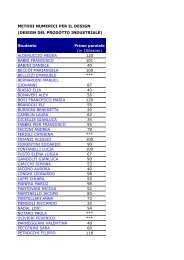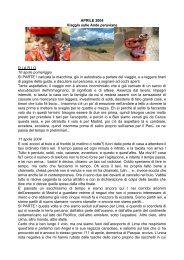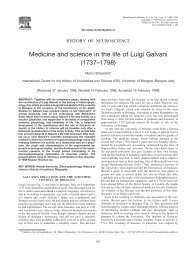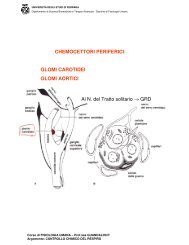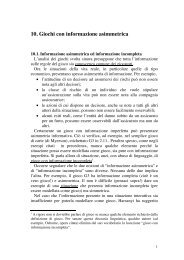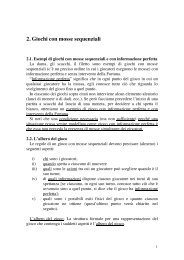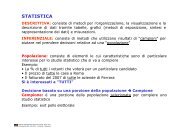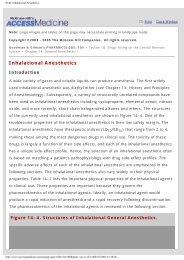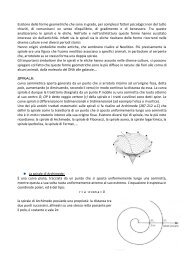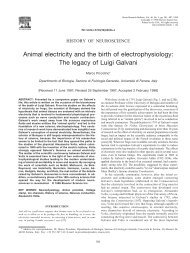EMERGENCY MEDICINE PRACTICE La sedazione per le ... - utenti
EMERGENCY MEDICINE PRACTICE La sedazione per le ... - utenti
EMERGENCY MEDICINE PRACTICE La sedazione per le ... - utenti
You also want an ePaper? Increase the reach of your titles
YUMPU automatically turns print PDFs into web optimized ePapers that Google loves.
o, randomizzato; 30 pazienti)<br />
52. Petrack EM, Marx CM, Wright MS. Intramuscular ketamine<br />
is su<strong>per</strong>ior to me<strong>per</strong>idine, promethazine, and chlorpromazine<br />
for pediatric emergency department sedation. Arch<br />
Pediatr Ado<strong>le</strong>sc Med 1996;150:676-681. (Studio prospettico,<br />
randomizzato, in doppio cieco; 29 pazienti)<br />
53. Dachs RJ, Innes GM. Intravenous ketamine sedation of<br />
pediatric patients in the emergency department. Ann Emerg<br />
Med 1997;29:146-150. (30 pazienti)<br />
54. Cotsen MR, Donaldson JS, Uejima T, et al. Efficacy of ketamine<br />
hydrochloride sedation in children for interventional<br />
radiologic procedures. AJR Am J Roentgenol 1997;169:1019-<br />
1022. (Studio prospettico; 211 pazienti)<br />
55. McGlone RG, Ranasinghe S, Durham S. An alternative to<br />
“brutacaine”: a comparison of low dose intramuscular ketamine<br />
with intranasal midazolam in children before suturing.<br />
J Accid Emerg Med 1998;15:231-236. (Studio comparativo;<br />
102 pazienti)<br />
56. Green SM, Hummel CB, Wittlake WA, et al. What is the<br />
optimal dose of intramuscular ketamine for pediatric sedation?<br />
Acad Emerg Med 1999;6:21-26. (Studio retrospettivo;<br />
1022 pazienti)<br />
57. Warner DL, Cabaret J, Velling D. Ketamine plus midazolam,<br />
a most effective paediatric oral premedicant. Paediatr<br />
Anaesth 1995;5:293-295. (Studio randomizzato, controllato;<br />
60 pazienti)<br />
*58. Green SM, C<strong>le</strong>m KJ, Rothrock SG. Ketamine safety profi<strong>le</strong><br />
in the developing world: survey of practitioners. Acad<br />
Emerg Med 1996;3:598-604. (Studio di sopravvivenza; 122<br />
rispondenti)<br />
59. Green SM, Rothrock SG, Harris T, et al. Intravenous ketamine<br />
for pediatric sedation in the emergency department: safety<br />
profi<strong>le</strong> with 156 cases. Acad Emerg Med 1998;5:971-976. (Studio<br />
retrospettivo su una serie consecutiva di casi; 156 casi)<br />
*60. Green SM, Johnson NE. Ketamine sedation for pediatric<br />
procedures: Part 2, Review and implications. Ann Emerg<br />
Med 1990;19:1033-1046. (Review)<br />
61. Strebel S, Kaufmann M, Maitre L, et al. Effects of ketamine on<br />
cerebral blood flow velocity in humans. Influence of pretreatment<br />
with midazolam or esmolol. Anaesthesia 1995;50:223-228.<br />
(Studio randomizzato, controllato; 24 pazienti)<br />
62. Ko<strong>le</strong>nda H, Gremmelt A, Rading S, et al. Ketamine for analgosedative<br />
therapy in intensive care treatment of head-injured<br />
patients. Acta Neurochirurgica 1996;138:1193-1199. (studio<br />
prospettico; 35 pazienti)<br />
63. Shannon M, Albers G, Burkhart K, et al. Safety and efficacy<br />
of flumazenil in the reversal of benzodiazepine-induced<br />
conscious sedation. The Flumazenil Pediatric Study Group.<br />
J Pediatr 1997;131(4):582-586. (Retrospective; 107 patients)<br />
*64. Chudnofsky CR. Safety and efficacy of flumazenil in reversing<br />
conscious sedation in the emergency department.<br />
Emergency Medicine Conscious Sedation Study Group.<br />
Acad Emerg Med 1997;4(10):944-950. (Studio multicentrico,<br />
randomizato, in paral<strong>le</strong>lo, in doppio cieco, in controllo<br />
con placebo; 179 pazienti)<br />
65. Gross JB, Blouin RT, Zandsberg S, et al. Effect of flumazenil<br />
on ventilatory drive during sedation with midazolam and<br />
alfentanil. Anesthesiology 1996;85(4):713-720. (Studio randomizzato,<br />
in doppio cieco, crossover; 12 pazienti)<br />
66. Shalansky SJ, Naumann TL, Englander FA. Effect of flumazenil<br />
on benzodiazepine-induced respiratory depression.<br />
Clin Pharmacol 1993;12(7):483-487. (Review)<br />
67. Mora CT, Torjman M, White PF. Sedative and ventilatory<br />
effects of midazolam infusion: effect of flumazenil reversal.<br />
Can J Anaesth 1995;42(8):677-684. (Studio comparativo, in<br />
doppio cieco; 16 pazienti)<br />
68. Chung DC, Rowbottom SJ. A very small dose of suxamethonium<br />
relieves laryngospasm. Anaesthesia<br />
1993;48(3):229-230. (Casi clinici; 3 pazienti)<br />
69. Davis DP, Hamilton RS, Webster TH. Reversal of midazolam-induced<br />
laryngospasm with flumazenil. Ann Emerg<br />
Med 1998;32(2):263-265. (Review)<br />
70. Matthews DE. Roberts T. Intraarticular lidocaine versus<br />
intravenous analgesic for reduction of acute anterior shoul-<br />
der dislocations. A prospective randomized study. Am J<br />
Sports Med 1995;23(1):54-58. (Studio prospettico, randomizzato;<br />
30 pazienti)<br />
71. Kosnik J, Shamsa F, Raphael E, et al. Anesthetic methods<br />
for reduction of acute shoulder dislocations: a prospective<br />
randomized study comparing intraarticular lidocaine with<br />
intravenous analgesia and sedation. Am J Emerg Med<br />
1999;17(6):566-570. (Studio prospettico, randomizzato, non<br />
in cieco; 49 pazienti)<br />
72. Ceroni D, Sadri H, Leuenberger A. Anteroinferior shoulder<br />
dislocation: an auto-reduction method without analgesia. J<br />
Orthop Trauma 1997;11(6):399-404.<br />
73. McNamara RM. Reduction of anterior shoulder dislocations<br />
by scapular manipulation. Ann Emerg Med 1993;22:1140-<br />
1144.<br />
Alcune citazioni sono tratte dal Columbia Dictionary of Quotation.<br />
The Columbia Dictionary of Quotation è stampato dalla Columbia<br />
University Press. Copyright 1993, 1995 da Columbia University<br />
Press. Tutti i diritti riservati.<br />
Domande<br />
I vantaggi della premedicazione con sedativi compredono<br />
tutti i seguenti eccetto:<br />
a. una procedura più controllata<br />
b. maggior soddisfazione dei pazienti/genitori<br />
c. minor sofferenza <strong>per</strong> il paziente<br />
d. costi minori<br />
Per evitare <strong>le</strong> disposizioni del JCAHO che prevedono la<br />
standardizzazione del<strong>le</strong> procedure anestesiologiche, i<br />
medici:<br />
a. dovrebbero utilizzare solo gli oppiodi e <strong>le</strong> benzodiazepine<br />
b. dovrebbero utilizzare il “distacco” “brutacaina”<br />
come approccio di scelta<br />
c. dovrebbero assicurarsi che il Dipartimento d’Emergenza<br />
dove lavorano abbia un iter dipartimenta<strong>le</strong><br />
standardizzato <strong>per</strong> la premedicazione<br />
con sedativi<br />
d. dovrebbero tentare una <strong>sedazione</strong> profonda, con<br />
l’implicita <strong>per</strong>dita di rif<strong>le</strong>ssi protettivi<br />
<strong>La</strong> Ketamina offre tutti i seguenti vantaggi eccetto:<br />
a. salvaguardia dei rif<strong>le</strong>ssi protettivi<br />
b. broncodilatazione<br />
c. rapida insorgenza d’azione<br />
d. mancanza di effetti collaterali al risveglio<br />
I potenziali vantaggi della <strong>sedazione</strong> controllata dal<br />
paziente includono:<br />
a. la <strong>sedazione</strong> non su<strong>per</strong>a il livello desiderato<br />
b. maggiore coinvolgimento e soddisfazione del<br />
paziente<br />
c. possibilità di impiego di farmaci a durata d’azione<br />
ultra-breve, che <strong>per</strong>mettono una veloce ripresa<br />
di coscienza<br />
d. tutte <strong>le</strong> precedenti<br />
Quando si utilizzano oppioidi e benzodiazepine in associazione:<br />
a. i farmaci antagonisti devono essere immediatamente<br />
disponibili<br />
b. i farmaci devono essere somministrati ogni 30<br />
secondi<br />
Settembre 2000 19<br />
Emergency Medicine Practice



